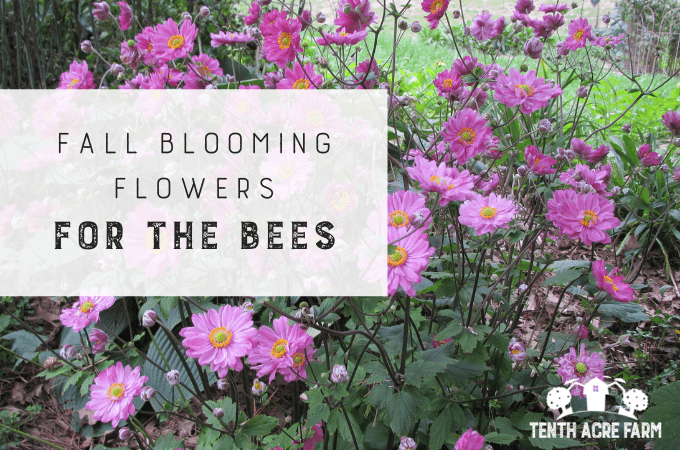Bees need to store up pollen and nectar to survive winter hibernation. Here are some tips on how to provide bees with the right fall forage to meet their needs.

This page may contain affiliate links. Please read my disclosure for more info.
Right now is the time that the adorable furry bumble bees are working overtime to forage for pollen and nectar in preparation for wintertime hibernation. They aren’t the only ones, all wildlife is frantic with last-ditch efforts to fatten up and store for the winter.
That’s why I provide a variety of late-blooming flowers for pollinators, and I leave the spent flowers so the birds have a source of seed, too.
Sound good? There’s only one key:
To have fall blooming flowers you’ll need to plant them in the spring!
Fall Blooming Flowers
Basil: Basil can be left to flower in the fall, attracting many kinds of pollinators. It will also allow you to collect your own seeds! (I like to grow Italian Genovese basil.)
Borage: Also called starflower or ‘bee bread’, borage is a self-seeding annual with star-shaped purple flowers. A companion to many vegetable and fruit crops, borage blooms all season long and delights the bees. It grows best in full sun.
Read more about all the reasons to grow borage.
Broccoli: The spring broccoli is mostly finished producing by the time fall rolls around, and leaving the plants lets the bees access the flowers. Broccoli plants that are allowed to overwinter will bolt (flower) in the spring and provide the bees with the all-important early season forage. I like to do this if I can give up the growing space.

Bee on broccoli flower
Calendula: Calendula flowers will bloom all year until the frost while attracting pollinators and other beneficial insects. I like to sprinkle the seed throughout the garden in early spring.
Read more about all the reasons to grow calendula.
An abundance of flowers allows me to harvest a few for myself to make calendula oil and healing salve. By late fall I can collect my own seed. Here are the calendula seeds that I bought.

Pollinator on calendula
Japanese Anemone: Japanese Anemone (pictured at top of this article) is one of my favorite additions to the garden. The foliage covers the ground nicely throughout spring and summer, and it provides spectacular blooms in the fall when everything else seems to be dying back. The bees sure are happy these blooms are here. Anemone particularly likes part shade/sun conditions.
Lemon Balm: Melissa officinalis is a delightful plant in the mint family. Melissa is the Greek word for bee, and its fall flowers will attract many pollinators in the fall. Although mints tend to take over an area with runners, lemon balm simply expands by clumping. It can easily be divided and spread around the garden. I love to grow it near vegetables, for the lemon scent repels pests, and it can be cut to use as fertilizer. It also makes the most wonderful tea.
Other fall blooming flowers that provide pollen and nectar for bees and other pollinators:
Have a tall fenceline? Border it with these tall beauties:
- aster
- perennial sunflowers (Here’s why I grow perennial sunflowers.)
- golden rod
- ironweed
Are you growing any late-season bloomers for pollinators?






Amy S says
I’m pretty sure that the “bee” on the calendula is a mimic. I had flies in my flower garden with that hourglass marking on their backs. I thought they were honey bees for the longest time. Nope, just a fly tricking me with its colors.
Amy says
Hmm. I was thinking it was a solitary bee. Maybe I should change the photo caption to say, ‘pollinator on calendula’ 🙂
Jeanie says
All pollinators are welcome,! They get bonus points for clever disguises! 😉
Julie says
Wonderful article thanks, bees are one of the most important insects on the planet and the more we can do to help them the better.
Dianne Stewart says
I grow about 30 lavender plants. I have been picking stems for a couple weeks in the company of mostly bumble bees and some honeybees. Bumble bees forage in my bouquets, so it’s entertain to watch them up close. At night, I noticed a a few flower heads with bumble bees fast asleep. I chuckled when one bee took a rock-a-bye ride on a stem that I disturbed, swaying back and forth, unaffected. We also have a lot of volunteer California poppies. Needless to say, but I am very fond and respectful of bumble bees and appreciate that they are generally docile.
Courtney says
Yes. i have maximillian, aster, anise hyssop. Yey. Good to know. Enjoy the posts. Should have a magazine.
Richard Keane says
Although we have many fall flowering plants in our gardens, I find most of our bumble bees sleeping in my sunflower heads